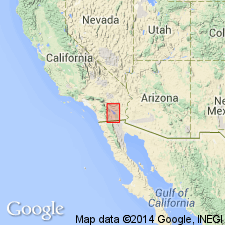- Usage in publication:
-
- Borrego formation
- Modifications:
-
- Areal extent
- Dominant lithology:
-
- Mudstone
- Siltstone
- Sandstone
- Conglomerate
- AAPG geologic province:
-
- Salton basin
Tarbet, L.A., and Holman, W.H., 1944, Stratigraphy and micropaleontology of the west side of Imperial Valley, California [abs.]: American Association of Petroleum Geologists Bulletin, v. 28, no. 12, p. 1781-1782.
Summary:
Pg. 1781-1782. Borrego formation. Nonmarine mudstones, siltstones, sandstones, and conglomerates. Thickness 0 to 7,600 feet. Probably unconformably overlies all older rocks. [Is younger than Palm Spring, Imperial, Alverson Canyon, and Split Mountain formations.]
Source: Publication; US geologic names lexicon (USGS Bull. 1200, p. 434-435).
- Usage in publication:
-
- Borrego formation
- Modifications:
-
- Areal extent
- AAPG geologic province:
-
- Salton basin
Tarbet, L.A., 1951, Imperial Valley, [California]: American Association of Petroleum Geologists Bulletin, v. 35, no. 2, p. 260-263.
Summary:
Pg. 261 (fig. 40), 262-263. Borrego formation. Consists of: red, buff, green, and yellow mudstones and sandstones containing nonmarine megafossils; and gray subangular pebble to cobble conglomerates containing redistributed volcanic rock, marine fossils, and fossil wood from older formations. Thickness 8,600+ feet. Unconformably overlies all older formations. [Shown on generalized columnar section younger than Palm Spring formation and older than alluvium lake deposits.] Age is early Pleistocene(?).
Source: Publication; US geologic names lexicon (USGS Bull. 1200, p. 434-435).

- Usage in publication:
-
- Borrego formation
- Modifications:
-
- Principal reference
- Dominant lithology:
-
- Claystone
- Sandstone
- AAPG geologic province:
-
- Salton basin
Summary:
Pg. 23 (fig. 2), 24, pl. 2 (geol. map). Borrego formation. Light-gray claystone with minor interbedded buff sandstone. Maximum thickness about 6,000 feet; thins eastward. Underlies Ocotillo conglomerate (unconformably in places) and gradationally overlies Palm Spring formation. Mapped (pl. 2, geol. map) as lacustrine facies of terrestrial Palm Spring. Fossils. Claystone contains a lacustrine fauna of minute mollusks, ostracodes, and foraminifers, and rare petrified wood. Name credited to Tarbet [and Holman], 1944 (AAPG Bull., v. 28, no. 12, p. 1781-1782). Age is probably late Pliocene.
Type section: in Borrego Badlands, San Diego Co., Imperial Valley region, southern CA.
Source: Publication; US geologic names lexicon (USGS Bull. 1200, p. 434-435).
For more information, please contact Nancy Stamm, Geologic Names Committee Secretary.
Asterisk (*) indicates published by U.S. Geological Survey authors.
"No current usage" (†) implies that a name has been abandoned or has fallen into disuse. Former usage and, if known, replacement name given in parentheses ( ).
Slash (/) indicates name conflicts with nomenclatural guidelines (CSN, 1933; ACSN, 1961, 1970; NACSN, 1983, 2005, 2021). May be explained within brackets ([ ]).

